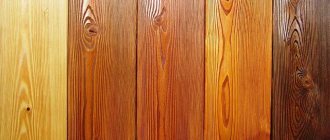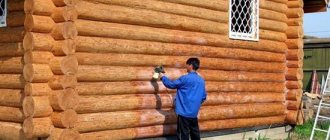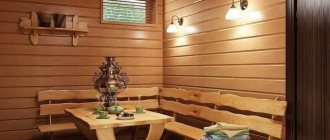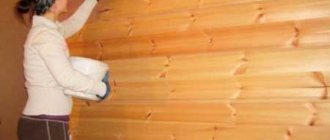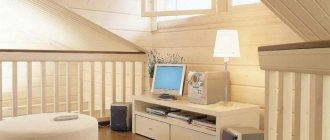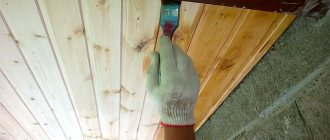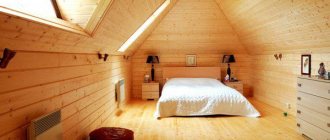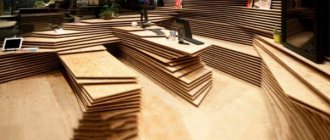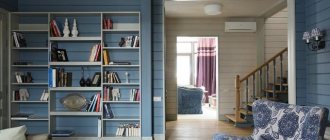Quite often, the interior decoration of a balcony, attic, or dacha room is decorated with wooden paneling. This material is especially popular, creating a comfortable indoor atmosphere and a favorable microclimate.
It is able to compete with modern materials: plastic panels, wallpaper, tiles. The lining absorbs high humidity and can release it in a dry room. Therefore, it is easy to breathe in rooms decorated with wood. The aroma of wood is not comparable to the smell of chemical finishing materials.
However, owners often encounter the problem that the lining has darkened over time; what should be done to restore its former beauty and attractiveness.
The lining has darkened, what to do?
Why does the lining darken?
Blackening of the cladding boards occurs quite often, especially in the case of carrying out construction work on one’s own. In this case, the wood processing technology is usually violated, leading to damage to the material by mold and mildew. As a result, the presentation of the wood becomes worse: it turns black, becomes saturated with moisture, and warps.
Most often, the reason for the color change of the lining is the adverse effects of the environment. In addition, the wood darkens as a result of improper maintenance or its low quality characteristics. For this reason, when decorating a balcony or cottage, many try to replace harmless and environmentally friendly material with toxic, fire-hazardous plastic.
A feature of any tree is the gradual loss of freshness and attractive appearance. This does not depend on the means with which the wood was treated before cladding.
You can use different types of lining:
- cedar shalevka is very sensitive to sudden temperature changes and the effects of water;
- linden material is more stable, but also darkens over time;
- pine and larch respond equally to weather conditions.
A competent approach to solving the problem guarantees the strength and reliability of wooden cladding.
Required materials and tools
In order to put the finishing in order, you will need the following available tools:
- bleaching composition for wood;
- brush;
- sponge;
- wide brush;
- roller;
- spray.
Darkened areas of the material that are caused by external climatic factors can be lightened using a bleaching solution.
In addition to traditional methods in the form of bleach, hydrogen peroxide or oxalic acid, special compounds are often used that protect the natural structure and do not clog the pores of wood.
These mixtures are non-toxic and fire-resistant; they do not destroy the texture of the material, but increase its level of wear resistance.
What to do if the lining darkens
There is no need to disassemble wooden panels that have lost their natural appearance and install new ones. Craftsmen have come up with many ways to lighten wood. They use:
- oxalic acid;
- hydrogen peroxide;
- bleach.
There are special ways and means to correct the situation and preserve the natural structure of the tree. To this end:
- treat the surface with a brightening compound;
- cover it with varnish of a lighter tone;
- sand;
- paint.
Whitening agents:
- do not spoil the structure of the tree;
- non-toxic;
- harmless;
- fireproof;
- give the material wear resistance.
All these whitening methods have not only advantages, but also disadvantages. When using brightening compounds based on active substances (chlorine, hydrochloric acid), in order to preserve their effect, the lining is coated with a light-colored protective varnish on top.
The greatest effect is achieved if the product is applied in several layers. The original appearance will not be achieved, but the exterior will improve significantly. Painting allows you to completely change the appearance of the surface, but the effect of the wood structure disappears.
The method of processing with sandpaper and further coating with acrylic makes it possible to return the lining to its former beauty and increase its resistance to weather changes. When processing the front surface, do not forget about the back side.
The use of an antiseptic will protect the wood from the development of fungus and mold, which cause darkening of the coating.
Chemical cleaning methods
When the darkening has penetrated deep into the thickness of the lamella, it is impossible to remove it mechanically; removing something too thick will lead to deformation and destruction of the entire finish. Traditional methods developed over the years on how to bleach darkened lining inside a house suggest using regular bleach or bleach. Processing should be carried out only in a well-ventilated area, wearing a respirator and gloves. The method is quite effective, but the fumes released over a long period of time can be harmful to health. This option is definitely not the answer to the question of how to bleach the lining in a bath; when heated, the remaining chlorine will evaporate and harm people’s health.
Preparing for painting
Before covering the lining with varnish or acrylic, it should be cleaned of dirt and degreased with an alkali-based solution, and then sanded with a flat pumice stone or a grinding wheel. This will require the following tools:
- sponge and brush to remove dirt from the surface;
- roller, brush or spray for applying restoring and brightening agents.
This operation leads to the loss of all the protective characteristics of the wood. To restore them, treatment with a disinfectant composition is necessary. It will not only protect the wood, but also improve the quality of the varnish coating.
How to paint lining correctly
Using regular oil paint to renew the surface gives it an artificial shine and hides the natural grain of the wood. In addition, such coating is short-lived and will soon require modernization. When using acrylic varnish on wood panels:
- the original pattern is preserved;
- ensures attractive appearance;
- creates lasting protection from moisture and weather changes;
- the service life of the cladding is extended (up to 8-10 years).
Depending on the degree of darkening, you can use the concentration of the solution as prepared or dilute it with water in a 1:1 ratio. To avoid differences in the tone of the coating, it is necessary to apply a test stroke in an inconspicuous place. After this, the paint color is selected.
The recovery procedure consists of step-by-step operations:
- surface cleaning;
- drying wood;
- antiseptic treatment;
- testing and selection of shade;
- applying acrylic paint.
The final finishing with clapboard is quite often used in the repair of balconies and cottages. In order for the cladding to maintain a beautiful natural appearance for a long time, you need to follow the rules for using wood material and know how to lighten it. To ensure high-quality restoration of darkened panels, you should choose the right bleaching method. For this purpose, it is advisable to consult with specialists or read the instructions.
Classification of painting materials
Darkened lining can be painted with oil, alkyd or acrylic paints to restore the attractiveness of the surface. Let's look at the advantages and disadvantages of each type of paint.
Oil paints
They have an unpleasant odor and are painted in good weather so that the room can be ventilated.
Positive sides:
- service life is approximately 5 years;
- the paint is well absorbed by wood and dries within 24 hours;
- oil coating protects against moisture;
- The low cost is captivating.
The disadvantage is the loss of shine during long-term use, it is difficult to apply another type of coating on top of this coating, and the oily surface does not breathe.
Alkyd paints
They are used for walls and floors. However, they should be applied to a completely dry surface, otherwise bubbles will form and the paint composition will then peel off. The alkyd composition is resistant to moisture and its cost is low.
Acrylic based paints
Experts recommend using these paints for lining because of their many advantages.
- Acrylic paints are environmentally friendly and do not harm human health. They breathe, protect from moisture and are resistant to sub-zero temperatures.
- Acrylic is odorless, dries quickly, without forming streaks.
- The surface remains attractive for a long time.
- However, you should not buy cheap types of acrylic paints - they can change color after drying. And also the process of applying acrylic is lengthy; it is necessary to apply the next layer after the previous one has completely dried.
Read about construction paints and new products on the market.
Advice from experienced craftsmen
- If you paint with oil paints, then the shade is chosen one tone darker than the desired color, since over time the surface becomes lighter.
- Do not paint in hot weather; drying occurs quickly and the surface may crack.
- The lining should be coated with polyurethane varnish, which will enhance the texture effect and naturalness of the wood.
- The color of natural wood is more suitable for bedrooms and country rooms.
So we looked at the issue, the lining has darkened, what to do . To enjoy attractive lining longer, you need to know about the basic rules for using wood and follow them. To choose lightening, consult with specialists.
If you find an error, please select a piece of text and press Ctrl+Enter.
Share with your friends on social networks!
How to bleach black boards?
For shallow bleaching, you can prepare a mixture of 40.0 grams of potash and 150.0 grams of bleach, which are dissolved in 1.0 liter of water. It can be used to lighten
fairly large areas of wooden surfaces. The solution is applied with a paint roller, and the degree of lightening is checked visually.
Interesting materials:
The laptop does not recognize the new battery, what should I do? What does Numlock do? Do you need to do homework? Do I need to make a power of attorney for a car? Is it necessary to do inhalations for bronchitis? Do I need to do a CTG every week? Is it necessary to survey a summer cottage? Is it necessary to have surgery for a herniated disc? Do I need to take breaks from taking vitamins? Is it necessary to re-landmark the dacha plot?
Prevention
To prevent the lining from turning black and deforming, it is enough to follow a few simple recommendations:
- if the facade of a building is covered with wooden clapboard, then it must be fixed at a short distance from the surface to be improved;
- after covering a wall, floor or ceiling with special boards, the building material must be processed (primed, varnished, painted, etc.);
- in a room lined with clapboard, you need to equip a good ventilation system;
- if it is impossible to install fans, regularly ventilate the room;
- Once every six months, the cladding board must be impregnated with a special protective compound, which minimizes the risk of mold and mildew and protects the building material from precipitation (how to treat lining with protective agents?).
And lastly: the higher quality lining is used for interior or exterior decoration, the less time and effort will be needed in the future to return the cladding board to its original appearance.
Reasons why lining processing is required
If there is excess moisture, the wooden lining will rot. Untreated thin wood easily catches fire and is damaged by insects.
Its correct use will reduce risks. First of all, reliable waterproofing of the walls and insulation of the balcony with non-flammable insulating materials are necessary. The balcony should be well ventilated, to prevent the appearance of condensation, cold bridges, and sudden temperature changes.
Wood in any condition requires mechanical and chemical protection to ensure its safety. Wooden lining on a residential balcony requires particularly careful environmentally friendly processing.
How to paint lining like bleached oak
Often it is necessary to paint the wood white, but so that the veins are visible. They also say to create the effect of bleached oak. There are several ways:
Whitewashed lining looks great both on the walls and on the ceiling
It’s difficult to say which composition to choose - you need to try. It is advisable to paint the lining with several compositions and compare the results. The effect when using different products is slightly different, but it also greatly depends on the wood. The reviews are also very different - some whitened with tinting, others with oil. Soils are rarely used for these purposes, but mainly because not everyone knows their properties.
How to whiten lining at home?
For such a room, a design in country style, Provence or, for example, in a marine style, is well suited if you want to play up the similarity of the lining with ship plating.
How can you use wooden lining in the kitchen interior?
The lining can be used to decorate walls in the kitchen in the dining area, and repeat the same wood colors in kitchen furniture. This type of finish is not suitable for kitchen ceilings, since it will be very difficult to clean such a ceiling from greasy fumes. The use of lining in the food preparation area is also unacceptable; it is better to decorate the “apron” with ceramic tiles, mosaics or special easy-to-clean polymer plastic.
Is it appropriate to decorate the walls with clapboard in an apartment in an apartment building?
Why not? You can cover not only the balcony or loggia of a modern apartment with lining, but also use this type of decoration for walls in the kitchen, hallway, or even in the bedroom. However, it should be remembered that the process of installing wooden lining itself implies the presence of sheathing, that is, a frame. Thus, finishing the apartment with clapboard will take up some of the usable space. Therefore, if your apartment is very small, you need to use lining for wall decoration with caution.
What kind of furniture to furnish a room decorated with clapboard?
Furniture in a room decorated with clapboard should harmonize well with it in style. Therefore, interior items should also be made of wood, because metal, plastic or glass are unlikely to fit well into such an interior. It’s great if the furniture is made of the same type of wood as the lining on the walls, but this is not at all necessary. You can, on the contrary, play on the contrast and choose furniture of a completely different tone. An interesting idea is to use rattan or bamboo furniture in a room decorated with clapboard.
How practical is it to use natural lining in the hallway?
The hallway and corridor are rooms in which it is important to maintain cleanliness, since dust and dirt are brought there from the street. Accordingly, the decoration of the hallway, including the walls, should allow for wet cleaning, or at least wiping with a damp cloth. The lining treated with special compounds is perfect for these purposes, so there is no reason to refuse wooden paneling in the hallway.
How to decorate a room lined with clapboard?
Emphasize the beauty of natural wood with antique decorative items, or souvenirs with a touch of provincial romance: figurines, vases, carved wooden crafts. Paintings depicting still lifes or calm forest landscapes harmonize well with the lining. Pay special attention to carpets and curtains. Bamboo or thread curtains made of wooden beads are perfect for decorating windows. And on the floor you can lay something like a mat or animal skin.
What to use?
Lining is a “breathing” building material, so it regularly absorbs dust, dirt, soot, and other types of contaminants from the air.
Coating its surface helps reduce damage to wood:
- impregnations;
- wax;
- paints (how to paint lining correctly?);
- varnish (how to varnish the lining?).
But even they will not completely protect the finishing board from stains appearing on it. What can and cannot be used to clean the lining?
Recommended means of removing contaminants from finishing materials include:
- soap solutions;
- scrapers with sharp bases;
- brushes for cleaning wood;
- grinding machines.
Before sanding the lining, you need to carry out a test stripping on a separate piece of material or on the least noticeable area of the surface being treated. Otherwise, instead of a clean slate, you may end up with completely damaged material.
What should not be used?
Do not clean the finishing board with:
- Hard metal brushes and sponges. Their aggressive impact will lead to an increase in wood porosity and even deeper penetration of contamination.
- Household chemicals (washing powder, dishwashing detergent, liquid soap). Such detergent compositions are not intended to work with lining, so the result of their impact on it is difficult to predict.
- Acidic, alkaline or chlorinated compounds for household use. For example, Belizna or Domestos are very helpful during cleaning, but they are completely unsuitable for disinfecting finishing building materials.
Firstly, all aggressive cleaning products have a strong, unpleasant odor that is absorbed into the wood literally forever. And, secondly, they reduce the protective functions of paints and varnishes, significantly reducing the service life of the lining.
Industrial bleaches
Often, summer residents are faced with a problem when boards stored in the fall during the winter storage period have lost their color, become old and mold has appeared on them. This is especially unpleasant when it comes to planed boards intended for finishing and cladding “under varnish” or for the construction of gazebos. To restore their original appearance, the industry produces an excellent whitening and lightening agent “Neomid”, which has antiseptic properties.
It removes moldy “blue”, brightens the surface and prevents the reappearance of mold and fungi. After treatment with this composition, black blurs, spots and dots are removed from wooden surfaces, and the material itself acquires the appearance of freshly planed wood. Unlike other clarifiers, Neomid penetrates shallowly into the thickness of the wood, without thereby disturbing its structure. Detailed instructions for use are included with the drug upon purchase.
There are other wood bleaching technologies and substances designed to lighten its surface. Here are the most affordable ones that you can use without additional costs or loss of time.
When professionally processing wooden surfaces, quite toxic solutions are often used, which makes no sense to use for the restoration of one table or door panel.
The review describes in detail a special product for bleaching wood.
Reasons for darkening of cladding boards
Unfortunately, residents encounter this problem quite often, in particular if they installed the boards themselves.
In this case, painting work is carried out with significant violations, which leads to deformation of the wood and the colonization of fungal and mold microorganisms.
Thus, the lining begins to gradually lose its original beauty, fills with moisture and begins to warp.
As a rule, darkening appears as a result of the negative influence of external factors. Also, such a nuisance occurs due to poor operating conditions or poor quality of the darkened material.
Therefore, very often owners, when sheathing a loggia, choose harmful and toxic plastic boards as an alternative to lining.
Know that any tree will begin to lose its color and along with it its attractiveness over time. This cannot even be affected by the product that was originally used to treat the darkened finishing material.
The following types of wood that have not yet darkened are used as cladding:
- Cedar shalevka (poorly tolerates temperature fluctuations and moisture).
- Linden (has good stability, but will lose color over time).
- Pine or larch (susceptible to atmospheric phenomena).
If you approach the problem with responsibility, the lining will serve you faithfully for a long time.
How much lining is needed to cover a balcony?
It is better to consider the algorithm for calculating the area of a room using the example of a 5x8 house, where we will cover the walls and ceiling with clapboard.
Next you need to calculate the square footage of one of the rooms. Let its length (a) be 5m, width (b) 4m, and height (c) 2.5m. And then everything was as we were taught in the school geometry course.
- Let's start with a long wall: multiply its height by length (ac) = 5x2.5 = 12.5 m2.
- The opposite wall will be the same size, so we simply multiply the result by two. 12.5x2=25 sq. m.
- Now, using the same principle, we find the size of the smaller wall (bc) = 4x2.5 = 10 square meters. Multiply by two. 10x2=20 sq. m.
- We multiply the length of the room by its width and get the ceiling area (ab) = 5x4 = 20 square meters.
- Let's summarize the data obtained from points 2, 3 and 4. And in addition, the square footage for finishing one room is 25 + 20 + 20 = 65 square meters.
We are trying to correctly calculate the area of the balcony
The calculation of the square of the balcony follows the same principle, only in this case, for convenience, it is better to divide each side into its constituent figures.
Take the appropriate measurements and calculate the area of the resulting figures using the formula.
Add it up and you get the balcony data.
Calculation of the required amount of material
How to calculate the amount of lining? First we need to know the size of the cladding material.
According to GOST, the thickness of a standard board should be 1.2-2.5 cm, length - 600 cm, and width up to 15 cm.
Panels up to 1.6 cm thick are used for interior decoration, and panels with a thickness of 1.8 cm are used for exterior work.
Knowing the width and height of the boards, we can also find out their square footage. For example, if their height is 600 cm and width is 9.5 cm, then the total area of the board will be 0.52 square meters.
To find out how many units of material will be needed to cover a room, divide its total area (walls and ceiling) by the area of one board.
You can also contact a consultant at any building materials store for help or calculate using a special calculator on the manufacturer’s website.
It is recommended to take the material with a reserve in case of defects or breakage during installation.
How to lighten treated wood?
If the coated lining has darkened over time, it is not so easy to lighten and repaint it; this is a long-term and complex process, therefore it is important from the very beginning to follow all the rules for performing painting and painting work when working with wood, so that you can then enjoy its beauty for a long time . But it's still possible
What should be done?
First of all, remove the old layer of varnish using all possible means. You can treat the paint layer with a heat gun, this is a good method, but there is a big drawback - the presence of a strong odor. You will definitely need a gas mask or powerful ventilation. It is less labor intensive. Restorator bleach in combination with a textured coating will help solve this problem. However, even in this case you will have to remove the varnish. If the varnish is water based, this will be easier to do.
Impregnations and coatings for lining on the balcony
In pursuit of cheap, practical building materials, we forgot about wood, which half a century ago occupied a leading position in construction. Now wood in a house is partly the roof, sometimes the floor, doors, furniture, and decoration.
For finishing residential premises, lining is used - lumber in the form of edged planed boards. Once upon a time, freight cars were sheathed with similar boards, which is where the name “lining” came from.
Due to massive deforestation and destruction of forests, the price of wood has risen. Not everyone can afford it. In addition, it is believed that wood requires special care and handling. But paneling on a balcony is not such an expensive solution: the area of the walls and ceiling for the cladding is small, and installation is easy to do with your own hands.
It is more difficult to process the lining on the balcony. But a balcony decorated with such material will look expensive and stylish! Every time you go out onto it, you will be able to inhale an indescribable woody smell.
What can I do to prevent the coating from turning yellow?
Proper care of the material helps to significantly extend the service life and protect against the influence of negative factors. Proper care will maintain the attractiveness of the coating .
Rules of care
- The material should not be heavily wetted, nor should aggressive chemicals be used for care. Important: To clean a dirty surface, you must use a soft cloth soaked in water. For more serious contamination, you need to use solvents with a weak chemical composition.
- When installing in rooms with high humidity, it is necessary to pre-treat them with a protective compound. Air should flow freely to the back of the board. The placement of the boards must be vertical. Under these conditions, excess moisture will not accumulate.
Some advice from experts
- To increase the service life of the finishing board, you can coat it with special wax. It should be noted that this cheap composition is sold in any hardware store.
- If during finishing work you leave an area of several square centimeters unsheathed, fresh air will circulate normally and preserve the surface for a long time.
By following all the rules for caring for the skin, you can maintain its beautiful appearance for a long time.
It is hardly possible to compare wood with any other building material. It was, is and will be the best that can only be used in construction. By using lining as finishing, you can make your home comfortable, cozy, and pleasant. And well-known rules for caring for it will extend its service life and preserve the attractiveness of the finish for a long time.
Choosing material for cladding the balcony
Lining made from coniferous trees (cedar, larch, pine) is used for both internal and external cladding.
Pine wood is very durable, although its color may darken over time. In addition, thanks to resins, pine lining is not subject to rotting. Cedar boards are recognized as one of the most wear-resistant. However, its main drawback is its high cost.
The temperature on glazed loggias and balconies in hot weather sometimes rises to 50-60 C°. Therefore, if the balcony is located on the sunny side, pine and cedar lining cannot be used for external and internal cladding under any circumstances, because resin may be released on the surface of the boards when heated.
Eurolining made of hardwood (aspen, linden, oak, alder) is used in most cases for interior decoration of balconies.
The most budget options are alder and aspen. However, they do have minor drawbacks. Firstly, eurolining made from these types of wood may darken over time. Secondly, alder has relatively high thermal conductivity.
Linden lining is the most popular and, perhaps, ideal option for interior lining of a balcony. Linden wood has a pleasant light golden color that does not change over time.
In addition, you do not have to treat it with impregnations and varnishes. Linden lining does not overheat, does not swell and practically does not contain knots. In addition, it has high sound insulation properties. And this is especially true when it comes to a balcony.
What type of eurolining is suitable for a balcony?
There are three classes of eurolining:
- Grade A – these are boards with virtually no knots or core on the surface. The surface of class A eurolining has a uniform shade and is ideally smooth.
- Grade B means that a small number of knots are allowed on the surface, the size of which should not exceed 15-20 mm. These are high quality boards with good performance properties.
- Grade C – boards with knots up to 25 mm in size, blind holes, stripes and recesses.
If your budget allows, then it is better to use high-quality class A eurolining as upholstery, since it is most resistant to damage and harmful environmental factors.
Grade B is slightly inferior in performance characteristics to class A; it can be given a solid four plus. This type of eurolining is cheaper. In popularity it is not inferior to class A.
Class C boards, which are the most budget option, are used least often as a facing material for balconies.
It is definitely impossible to answer the question which eurolining is best for a balcony. After all, everything depends not only on the wood and type of material, but also on the climate zone, as well as on whether the balcony is located on the sunny side or not. Be sure to consider these factors.

